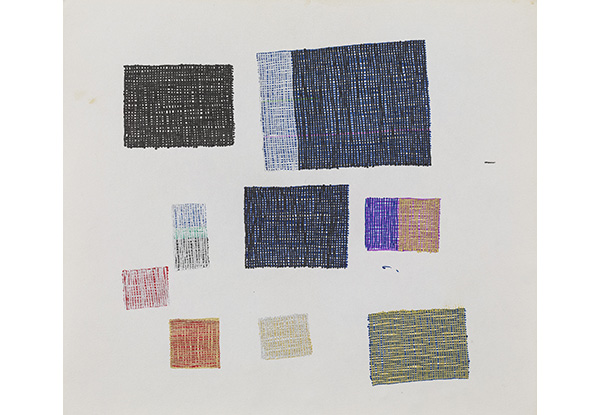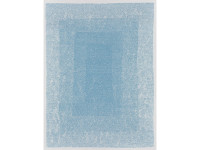
Between moments – between hollows: Liu Deng solo exhibition
| Artist Liu Deng has a very humble and reserved nature. It seems as if he is trying to blend into the environment in order to avoid attracting attention.The first time I met him I understood his discomfort with words and explanations. It is not about lack of empathy or mistrust, but more about a peculiar sense of time and space; he seems worried that too many words might literally occupy the moment that one experiences his paintings for the first time.
In presenting his works silently, he was suggesting that conversation should develop slowly, growing in an accurate and respectful relationship with the act of looking and the desire of seeing. When I visited his studio, until this balance was achieved between us, I could feel his discomfort, which suddenly turned into a quiet and warm welcome as soon as the rhythm of our chat became in tune with his expectations. After having become acquainted with the complexity and repetition of his patterns of knots, built with pen, ink, or brush, I felt that the time had come for those questions he had earlier left unanswered. Opening up our conversation with the sentence “If I hadn’t become an artist I would have ended up in jail,” accompanied by a contained but spontaneous laugh, he then picked up a pen and a paper and started drawing a few patterns of knots, explaining how all the possibilities of intersecting lines and patterns were, at the same time, exciting and therapeutic because they organized and distributed the methodical gestures necessary for the finished pattern to appear. Now if I was able to make the reader perceive the authenticity and the “quality” of this simple moment, when, sitting on the couch with his cigarette, Liu Deng “explained” his paintings by directly repeating the movements that first started this exploration, I would not need to write this text. Unfortunately, this quality cannot be reproduced and so I can only suggest a visit to his studio and, eventually, being lucky enough to experience it directly. In what follows, I will try to articulate some words concerning Liu Deng ‘s work, bearing enough respect and accuracy in my description to inspire in the reader a desire to go visit him. When I asked him why or how he became interested in representing knots and plots, he answered that his father was a mechanic and an electrician and so he used to see wires intersecting each other all around the place when his old man was working. This obvious explanation, unaccompanied by any other emphatic or artificial construction in order to raise or justify interest in his work, was in itself a revelation and a sign of trust. Then he added how he started to make collages of objects and wires and that these were his first artworks, but when he discovered that he could simply draw or paint on a paper the space and the ways wires can intersect each other, he felt he did not need objects anymore and even the range of colors could be reduced. He added that sitting down, facing the surface of a large sheet of rice paper with a pen or a brush simply made him feel good, or “shufu”, the very soft and childlike-sounding word Mandarin has to describe an all-over feeling of fullness and calm. At this moment I understood that all I needed to know was there in front of me: his memories, his paintings and the gestures that built them. Liu Deng had shared with me the intimacy of his creative process and expressed the necessity behind it, where it was coming from and why he was engaged in it. This utter honesty and his refusal to offer any artificial construction of personal mythology or higher motivations and causes behind his work, confirmed the refreshing feeling I had when looking at his paintings. These endless intersections of lines articulate the positive and negative space in a dense plot of plans, surfaces and patterns in which the liveliness of ink is limited but not constrained. Despite the accuracy of the process, there is no trompe-l’oeil effect, or attempt to mime or reproduce a certain texture to cheat the eye.The weave of the ink lines blends into the weave of the rice paper fibers, but it resists interpretation and symbolism, remaining basically “just what it is”. Although Liu Deng sometimes divides his paintings into two halves or three sections in which the pattern mutates, pairing primary colors or simply decreasing or increasing the intensity and the tone of one tint, an almost “natural” drive seems to push his works towards the disappearance of colors, favoring a delicate black or grey line. One day, perhaps this line will become white and blend completely into the paper, leaving traces that can be clearly perceived (because the surface has been touched and washed and consequently bent and warped) but are almost invisible to the eye. It is only towards the end of the time we spent together, after a meal, that he “confessed” how he dreams of making a painting with a pattern of thousands of invisible interlaced lines. In this moment I felt my perception of his work was confirmed. Liu Deng’s paintings stand in front of us in their structure and in their presence, hiding nothing, referring nothing, implying nothing, refusing an explicit causality beyond the artist’s necessity to act and his feeling “comfortable,” “shufu,” just by engaging in the gestures that bring them into existence. We can like them or not, project meaning onto them or not, or criticize them, but they will remain mute and present. There is no attempt to seduce us or to manipulate our perception, just their presence. In a sincere effort to find references for a work in which immanence and continuity complete each other so clearly, I want to start from the connection to Taoism but I will spare the audience and the work itself from the clumsy attempt to be discussed or described in these terms, which are too often banal, by instead pointing out that Liu Deng’s paintings embody Lao Tze’s founding sentence: “The Tao that can be spoken is not the eternal Tao.”This said, I would like to contextualize his work using both Western and Chinese specific references to the notion of time and being. The first one brings me back to my cultural roots, and is the Ancient Greek word Kairos. It signifies a time lapse, a moment of indeterminate time in which everything happens.The word has two different conceptual meanings, one coming from the art of archery and one from the art of weaving. Both help me in investigating Liu Deng’s work. In archery, kairos refers to an opening, or “opportunity” or, more precisely, a long tunnel-like aperture through which the archer’s arrow has to pass. Successful passage of a kairos requires, therefore, that the archer’s arrow be fired not only accurately, but with enough power for it to penetrate.The second meaning of kairos can be traced back to the art of weaving.There, it is “the critical time” when the weaver must draw the yarn trough a gap that momentarily opens in the warp of the cloth being woven. Putting the two meanings together, one might understand kairos to refer to a passing instant when an opening appears which must be driven through with force if success is to be achieved. In my mind, the notion of Kairos could explain Liu Deng’s approach to making art, his attitude and the quality of his paintings, yet, where my analysis falls short is the fact that Liu Deng is not Greek but Chinese, and despite the intuition that somehow his work has a resonance with the concept of “kairos”, this Greek concept still implies the notion of an act carried out in one single special moment, while Liu Deng’s practice seems to suggest both a moment of enlightenment, but also a timeless repetition.This contradiction would create an impasse if we remain in the mode of Western thinking, but instead becomes an opportunity if we shift to Eastern traditions and specifically to the notion of time. As noted by Emmanuel Lizcano, traditional Chinese thought has not produced anything like the concept of “time” as conceptualized within Western philosophy. For Chinese rationality, space and time form an interdependent unit: space is full of heterogeneous meanings according to places, and time appears linked to places and events. The reason this conceptual practice came into being may be connected to a few aspects of Chinese thought not expressed in Western culture.The first aspect is that in Chinese tradition there is no link between temporary phenomena and movement, and therefore to the phenomenon of space. Rather than thinking of movement as made up of individual bodies in motion, China has instead conceived of movement in reference to correlating factors, established as poles emanating energy, from which endless interaction flows.The resulting conceptualization of motion has therefore been more about the phenomena of process, of influence and transformation. Another aspect is the absence of an equivalent notion of eternity. Instead, China developed the notion of constancy.The difference is important because “constant” means:”that which does not change within the variation” and “eternal” means “that which does not become “. Both terms show permanence, but in a different ways. So if the eternal is “beyond time”, the constant is “never interrupted”. According to Zhuang Zi :”Permanence means to forget differences between times”. The last aspect is the absence in Chinese language, until relatively recently, of expressions related to “being” as understood in the West. Francois Cheng explains:“One of the most striking aspects of Chinese language is the absence of the verb “to be” as a predicate.”Identity is indicated by simple juxtaposition. As a consequence, there simply was nothing that equated to the “essence of something”. Traditional Chinese culture “did not think time” in the way we are familiar with and they translated the word “time” from Japanese when they encountered it through European thought in the late nineteenth century. Time was translated into Chinese as “between moments:” Jap=jikan Chi=Shijian. Space, likewise, was translated as “between hollows” Jap=kukan, Chi=kongjian. As opposed to time, the Chinese thought of the “moment” as a seasonal time. Finally, this all linked to one of the matrix ideas of Chinese culture, that of “Change” as embodied in the homonymous book of I-Ching. Now, in my understanding, the action, the state of mind, and the quality of Liu Deng’s works are to be found in the interplay between the weft and warp of these concepts, as they develop their own pattern of lines and form on top of and through those already present in the rice paper. I feel I cannot escape building a multi- layered, woven texture of words to try and give the feeling of that first moment I described earlier.In order to maintain the visual balance and the intimacy of the artist’s process, for this show, we have chosen to exhibit few works, in which the presence of color is not excluded, but limited. This is to suggest that specific direction towards the invisible work Liu Deng himself claims to aspire to. We hope our words, our display might be able to harmonize with and share that quality of authenticity and necessity that the painter made present in that moment, with a piece of paper, inviting us to see how he built his works, line by line, plan by plan.I have kept the paper from that first meeting for myself, with a sense of privilege to have witnessed the quality and selflessness of this gesture. When we parted I asked him if all my questions had bothered him. He took a moment and then, with a half smile, said that he was surprised and glad that I was actually so interested in his paintings and that the last time a person wanted to write about his work, he simply walked around his studio for 10 minutes and then left without asking anything. Although Liu Deng, because of this, seemed genuinely happy because of our exchange, I could not help thinking that perhaps that person who walked away so early had understood immediately how those works so resolutely resist interpretation. Alessandro Rolandi, Beijing, 29/01/2016 |
 |

